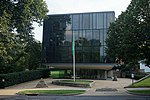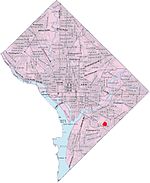Embassy of Italy, Washington, D.C.

The Italian Embassy in Washington, D.C. is the diplomatic mission of the Italian Republic to the United States, and the seat of the Italian Ambassador to the United States. The original Italian diplomatic mission to the United States following Italian unification was founded by Baron Saverio Fava. The current chancery is located just off Embassy Row at 3000 Whitehaven Street, Northwest, Washington, D.C. In 1972, the Italian government purchased property from the Andrew W. Mellon Foundation that was part of the campus of the neighboring Center for Hellenic Studies. The new building was designed by Piero Sartogo Architetti and was constructed in 1996.
Excerpt from the Wikipedia article Embassy of Italy, Washington, D.C. (License: CC BY-SA 3.0, Authors, Images).Embassy of Italy, Washington, D.C.
Whitehaven Street Northwest, Washington Georgetown
Geographical coordinates (GPS) Address External links Nearby Places Show on map
Geographical coordinates (GPS)
| Latitude | Longitude |
|---|---|
| N 38.917777777778 ° | E -77.060277777778 ° |
Address
Embassy of Italy
Whitehaven Street Northwest 3000
20008 Washington, Georgetown
District of Columbia, United States
Open on Google Maps











